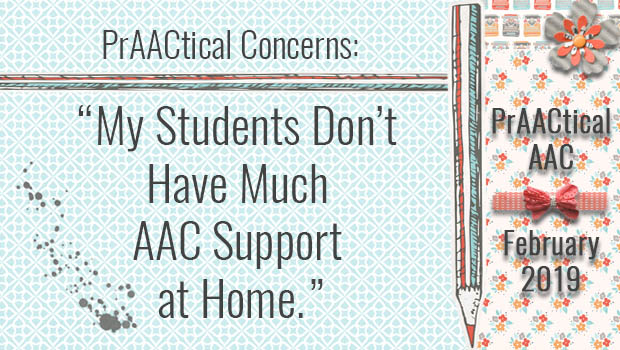“My Students Don’t Have Much AAC Support at Home”

At a conference last month, I had some wonderful interactions with teachers and SLPs who are incredibly dedicated to helping their students with AAC needs become more proficient communicators. A number of common threads emerged through comments like these.
- “It’s really frustrating! My student would make SO much more progress if there was carryover at home.”
- “I keep telling my student’s parents this but they don’t really follow through.”
- “I’ve told them about the research and shared a lot of web links with them, but nothing seems to change. My student’s family still doesn’t really use his AAC at home.”
- “The family tells me that they are modeling AAC, but when I look at the ‘history’ it shows that not much AAC is happening outside of school hours.”
In person and through social media, professionals have shared their stories and expressed that they are sometimes surprised and puzzled but mostly disappointed and frustrated. A few have even felt so ineffective that they’ve stopped working with these families. No professional likes to be in that position, and certainly, no one wins in those situations. These professionals want their students to succeed and know that the best way to make that happen is to help families adopt supportive AAC strategies. Giving up on a family feels awful, and certainly isn’t what these professionals had hoped would happen. It rarely does. Often, though, our attempts to help families implement AAC at home are less than successful and this can lead to frustration from both parties.
What can we do to prevent things from getting to that point? There are no easy answers or quick fixes, but here are some things to try.
- “First, seek to understand” (S. Covey). Learn more about this family, their lifestyle, routines, and priorities. Understanding where the family is coming from makes a huge difference in how we approach these situations and can make the difference between implementation and abandonment. Consider these two students with AAC needs.
- Javonne has a single-income family with a stay-at-home parent who shuttles their children to several afterschool enrichment activities, medical appointments, and therapy sessions each week. They frequently ask his teachers and school SLP to send homework and resources that can be shared with private therapists and have an advocate who attends Javonne’s IEP meetings. On weekends, they have in-home services from a BCBA for at least 4 hours/day and generally go on an outing to a museum or park in the afternoons. Javonne’s parents use respite services on a regular basis and recently remodeled their home to be more disability-friendly.
- Willa’s parents both work long hours at low-income jobs. They utilize before-school and after-school care and do not have sufficient transportation, time, or funds to access private therapy services. It is difficult for them to attend IEP and other school meetings, as leaving work during normal business hours puts their jobs at risk. They’ve been close to eviction on a few occasions. On the weekends, Willa spends time with her grandmother, who also watches 3 other grandchildren while their parents work. Willa’s family is very involved in their faith community, and they attend services, Bible study, and youth group as often as possible. The 5 of them live in a 2-bedroom apartment that lacks important safety and accessibility features.
- Clearly, these are vastly different circumstances. Will the same approach will work for both of them? Not likely. Understanding more about their lives allows us to tailor our expectations and supports. Families, like users of AAC, are diverse and do best when our expectations and supports take their individual situations into account. When you have a family who is struggling with AAC implementation, it can help to stop for a moment and think about what you really know about that family and determine whether getting to know them better is a good next step in your own AAC journey.
- Reframe the issue. Armed with the information you gleaned in step 1, turn your attention to solution strategies. It can be helpful to ask, “What will it take, realistically speaking, to help this family better support the AAC needs of their child?” When we’re brave enough to ask “What can I do to help you better support Child’s communication learning?” we often get valuable insights.
- Prepare to change your approach. Accept that doing things the way they’ve been done in the past is not likely to yield different results, and then consider exploring new approaches. Take an inventory of what you’ve tried so far, such as explaining the importance of a strategy in a meeting or sending home a handout or note about it. If it gave you the results you were looking for, keep at it. If not, reflect: What is your best guess as to why that was unsuccessful? What else could you try?
- Understand that, in most instances, telling people what to do, whether that is in a meeting, an email, or on paper, is likely to raise awareness but not change behavior. For behavioral change, we’ll need to invest in training, practice, coaching, feedback, and self-reflection.
- “But I don’t have time for that! I can barely keep up with the things I’m doing now. There isn’t room on my plate for one more thing!” That may well be true since being seriously overworked is the norm for most AAC service providers. Many, if not the majority, of AAC interventionists are struggling under the load and regularly find that there are a lot of unmet needs at the end of the work week. People deal with this reality in different ways, often trying to craft a more reasonable workload, experimenting with things they can do to be more efficient, or dropping some tasks/activities to free up their time and energy. And, sometimes, they just hit the pause button so that they can breathe a little before racing off to catch up with life once again. It’s okay to be in that place, as long as we don’t overstay our time there.
- Get back in the game. We need time to breathe, to reflect, to plan, and to prepare, and we shouldn’t judge ourselves harshly for it. But then we have to pick ourselves up, brush off the dust, and try another approach. Maybe it is formal training, or setting up opportunities for guided practice, or sending videos of our sessions. Maybe it is demonstrating the target strategy a few more times, making more frequent contact, or asking more questions. Maybe we’re ready to try a coaching model or create a parent support group. Whatever it is, we keep moving forward.
Helping families become better communication partners and AAC supporters is part of what we do. We may not always be effective or feel successful right away, but when one thing doesn’t work, we can always try something else. Helping families to support AAC at home may be the most powerful thing we can do for their children.
Do you have favorite strategies or tips for helping families who are traveling the AAC Road? We’d love to hear about them.
Filed under: Featured Posts, PrAACtical Thinking
Tagged With: family, home, parents, partner skills
This post was written by Carole Zangari





4 Comments
Love love love this! Its so important to understand behind the scenes. Immediately I will start a checklist of strategies and be sure to always ask : what can I do to support your child’s communication ?”
Such a great post! It’s a healthy reminder that, as educators, we have to look beyond what we are “supposed” to do.
Powerful post!
When I visited CPEC this summer, I asked a parent, what the most important research question to them was. They shared that it was “what does it take to help parents become invested in their children’s aac systems?” The idea you share of meeting people where they are at seems very valuable. We have been studying coaching for this reason.
I landed here because we are currently in the midst of a rejected IEP because the family does not believe the student’s AAC needs are being met adequately. The would like in-home training on the use of the student’s device, for one. They claim, and have told outside evaluators, that the student is not proficient using the device. It’s frustrating for me because I work with him, consider myself competent in teaching AAC use, and have tried every tool in my tool box to get this family to “buy-in”. The student reports his family does not want to use the device at home. Even in a meeting, one parent said that AAC use is not permitted when the student works with that parent because that parent wants the student to speak only verbally. The family isn’t on the same page. The other tricky variable is that the family is non-English speaking. This is my toughest case, by far.